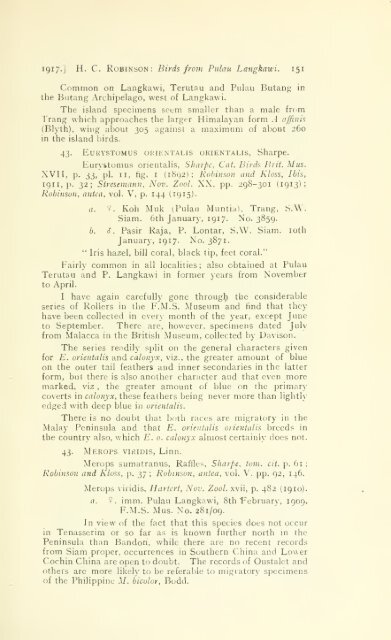Journal of the Federated Malay States museums - Sabrizain.org
Journal of the Federated Malay States museums - Sabrizain.org
Journal of the Federated Malay States museums - Sabrizain.org
Create successful ePaper yourself
Turn your PDF publications into a flip-book with our unique Google optimized e-Paper software.
I9I/-J H. C. Robinson: Birds from Pulau Langkawi. 151<br />
Common on Langkawi, Terutau and Pulau Butane in<br />
<strong>the</strong> Butang Archipelago, west <strong>of</strong> Langkawi.<br />
The island specimens seem smaller than a male from<br />
Trang which approaches <strong>the</strong> larger Himalayan form A affinis<br />
(Blyth), wing about .505 against a maximum <strong>of</strong> about 260<br />
in <strong>the</strong> island birds.<br />
43. EURYSTOMUS ORIENTALIS OKIENTALIS, Sharpe.<br />
Eurystomus orientalis, Sharpe, Cat. Birds Brit. Mus.<br />
XVII, p. jj, pi. 11, tig. 1 (1892); Robinson and Kloss, Ibis,<br />
1911, p. 32; Stresemann, Nov. Zoo!. XX, pp. 298-301 (1913)<br />
Robinson, antea, vol. V, p. 144 (1915).<br />
a. '. Koh Muk (Pulau Munti.ii. Trang. S.W.<br />
Siam. 6th January, 1917. No. 3859.<br />
b. i. Pasir Raja, P. Lontar, S.W. Siam. 10th<br />
January, 1917. No. 3871.<br />
" Iris hazel, bill coral, black tip, feet coral."<br />
Fairly common in all localities; also obtained at Pulau<br />
Terutau and P. Langkawi in former years from November<br />
to April.<br />
I have again carefully gone through <strong>the</strong> considerable<br />
series <strong>of</strong> Rollers in <strong>the</strong> F.M.S. Museum and find that <strong>the</strong>y<br />
have been collected in every month <strong>of</strong> <strong>the</strong> year, except June<br />
to September. There are, however, specimens dated July<br />
from Malacca in <strong>the</strong> British Museum, collected by Davison.<br />
The series readily split on <strong>the</strong> general characters given<br />
for E. orientalis and calonyx, viz., <strong>the</strong> greater amount <strong>of</strong> blue<br />
on <strong>the</strong> outer tail fea<strong>the</strong>rs and inner secondaries in <strong>the</strong> latter<br />
form, but <strong>the</strong>re is also ano<strong>the</strong>r character and that even more<br />
marked, viz , <strong>the</strong> greater amount <strong>of</strong> blue on <strong>the</strong> primary<br />
coverts in calonyx, <strong>the</strong>se fea<strong>the</strong>rs being never more than lightly<br />
edged with deep blue in orientalis.<br />
There is no doubt that both races are migratory in <strong>the</strong><br />
<strong>Malay</strong> Peninsula and that E. orientalis orientalis breeds in<br />
<strong>the</strong> country also, which E. 0. calonyx almost certainly does not.<br />
43.<br />
MEROPS VIRIDIS, Linn.<br />
Merops sumatranus, Raffles, Sharpe, torn. cit. p. 61<br />
Robinson and Kloss, p. 37; Robinson, antea, vol. V. pp. 92, 146.<br />
Merops viridis, Hartert, Nov. Zool. xvii, p. 4S2 (1910).<br />
a. ?. imm. Pulau Langkawi, 8th February, 1909.<br />
F.M.S. Mus. No. 281/09.<br />
In view <strong>of</strong> <strong>the</strong> fact that this species does not occur<br />
in Tenasserim or so far as is known fur<strong>the</strong>r north 111 <strong>the</strong><br />
Peninsula than Bandon, while <strong>the</strong>re are no recent records<br />
from Siam proper, occurrences in Sou<strong>the</strong>rn China and Lower<br />
Cochin China are open to doubt. The records <strong>of</strong> Oustal' t and<br />
o<strong>the</strong>rs arc more likely to be referable to migratory specimens<br />
<strong>of</strong> <strong>the</strong> Philippine .1/. bieolor, Bodd.<br />
; ;
















